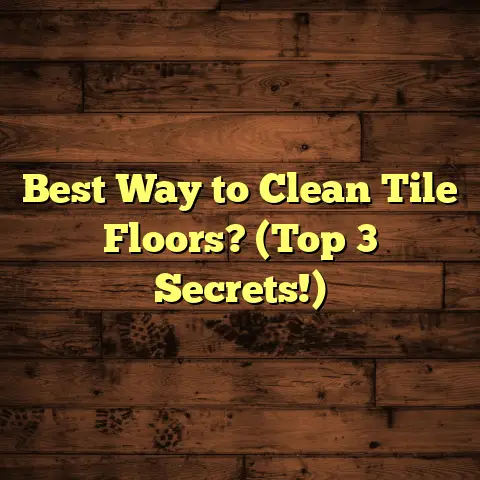Cat Pee on Hardwood? (5 Stain Removal Secrets!)
Ugh, the dreaded discovery! You walk into a room, and that smell hits you. Cat pee on your beautiful hardwood floors. It’s frustrating, it’s urgent, and you’re probably thinking, “How am I going to get rid of this?!”
Trust me, I’ve been there. As a flooring contractor for over 15 years, I’ve seen it all. The good news? It’s not always a disaster.
The key to successfully removing cat urine stains lies not just in cleaning but in understanding the science of stain removal and odor neutralization.
I’m going to share five effective stain removal secrets specifically designed for cat pee on hardwood floors. These are practical, actionable solutions that I’ve used countless times to help homeowners like you save their floors. Let’s dive in!
Section 1: Understanding the Problem
Why is cat pee such a pain on hardwood? It’s not just the smell; it’s the composition of the urine itself.
Cat urine is highly concentrated, containing uric acid, urea, creatinine, and electrolytes. This potent cocktail allows it to penetrate the finish and even the wood itself.
Think of your hardwood floor like a sponge. The urine seeps into the pores, leaving behind stains and lingering odors that seem impossible to eliminate.
The longer the urine sits, the deeper it penetrates, making removal more difficult.
Plus, the moisture can damage the wood fibers, leading to warping or discoloration.
Did you know that cat urine odor can linger for years if not properly treated? I once had a client who tried everything to remove the smell themselves, and by the time they called me, the urine had soaked so deep, we had to replace the affected planks.
And let’s not forget the health risks. Cat urine contains bacteria that can be harmful, especially for children or individuals with weakened immune systems.
Ammonia, a byproduct of urine decomposition, can also irritate the respiratory system.
Before you even think about cleaning, you need to identify the stain. Is it a fresh puddle, or has it been there for a while? How large is the affected area?
The age and size of the stain will influence the cleaning method you choose.
I always recommend using a UV flashlight to locate hidden urine spots. Cat urine glows under UV light, making it easier to find even the smallest stains. It’s a game-changer!
Section 2: Secret #1 – The Power of Enzymatic Cleaners
Enzymatic cleaners are my go-to weapon against cat pee. They’re not just masking the odor; they’re actually breaking down the uric acid crystals that cause the smell.
These cleaners contain enzymes that “digest” the organic matter in the urine, effectively eliminating the stain and odor at its source.
How do they work? The enzymes act as catalysts, speeding up the breakdown of uric acid into carbon dioxide and ammonia, which then evaporate.
It’s like tiny Pac-Men gobbling up the pee!
What brands do I recommend? I’ve had great success with Nature’s Miracle, Rocco & Roxie Stain & Odor Eliminator, and Anti-Icky-Poo.
Make sure to choose a product specifically formulated for pet urine and safe for hardwood floors. Always read the label carefully!
Here’s my step-by-step guide for applying enzymatic cleaners:
-
Blot up any excess urine: Use paper towels or a clean cloth to absorb as much of the fresh urine as possible. Don’t rub, as this can spread the stain.
-
Saturate the stain: Apply the enzymatic cleaner liberally to the affected area, ensuring that it penetrates deep into the wood. Don’t be afraid to really soak it!
-
Soak time is key: Follow the manufacturer’s instructions for soaking time. This is crucial for the enzymes to work effectively. Usually, it’s several hours or even overnight.
-
Cover the area: To prevent the cleaner from drying out too quickly, cover the area with plastic wrap or a damp towel. This will help the enzymes stay active longer.
-
Let it air dry: Remove the covering and allow the area to air dry completely. Don’t use a hairdryer or fan, as this can trap the odor.
-
Repeat if necessary: For stubborn stains, you may need to repeat the process several times. Patience is key!
I remember one client who had a particularly bad stain on their antique oak floor. They had tried everything, but the smell just wouldn’t go away.
I recommended using an enzymatic cleaner and told them to be patient. After three applications, the stain and odor were completely gone!
Section 3: Secret #2 – Homemade Solutions
Don’t want to run to the store? You can try some DIY cleaning solutions using common household ingredients.
Vinegar, baking soda, and hydrogen peroxide can be effective for removing cat pee stains, but they also come with limitations.
Vinegar is a natural disinfectant and deodorizer. It can help neutralize the ammonia in cat urine.
Baking soda is an excellent absorbent and can help draw out the stain and odor.
Hydrogen peroxide is a mild bleaching agent that can help lighten the stain.
However, these solutions may not be as effective as enzymatic cleaners for breaking down uric acid. They may also damage the finish of your hardwood floor if used improperly.
Always test on a small, inconspicuous area first to avoid damaging the finish!
Here are a few recipes I’ve used successfully:
Vinegar Solution:
- 1 part white vinegar
- 1 part water
Apply the solution to the stain, let it sit for 30 minutes, and then blot it up with a clean cloth.
Baking Soda Paste:
- Mix baking soda with enough water to form a paste.
Apply the paste to the stain, let it dry completely, and then vacuum it up.
Hydrogen Peroxide Solution:
- 3% hydrogen peroxide
- A few drops of dish soap
Apply the solution to the stain, let it sit for a few minutes, and then blot it up with a clean cloth. Be careful with this one, as it can lighten the wood!
I had a client who was hesitant to use harsh chemicals on their hardwood floor. They opted for the vinegar solution, and it worked surprisingly well on a relatively fresh stain.
However, for older, more stubborn stains, homemade solutions may not cut it.
Section 4: Secret #3 – Professional Cleaning Services
Sometimes, despite your best efforts, the stain and odor persist. That’s when it’s time to call in the professionals.
Professional cleaning services have specialized equipment and cleaning solutions that can penetrate deep into the wood and remove even the most stubborn cat urine stains.
They may use steam cleaning, hot water extraction, or other advanced techniques to lift the stain and neutralize the odor.
What can you expect from a professional cleaning service?
-
Thorough inspection: They’ll assess the extent of the damage and identify all affected areas.
-
Pre-treatment: They’ll apply a specialized cleaning solution to break down the stain and odor.
-
Deep cleaning: They’ll use professional-grade equipment to extract the stain and odor from the wood.
-
Post-treatment: They’ll apply a sealant or protectant to prevent future stains.
How much will it cost? The cost of professional cleaning services can vary depending on the size of the affected area, the severity of the stain, and the type of cleaning method used.
Expect to pay anywhere from \$100 to \$500 or more.
Is it worth it? If you’ve tried everything else and the stain and odor are still there, professional cleaning services can be a worthwhile investment.
They can save you the cost of replacing your hardwood floor.
How do you choose a reliable cleaning service?
-
Ask for referrals: Get recommendations from friends, family, or neighbors.
-
Read online reviews: Check out their reputation on sites like Yelp or Google.
-
Get multiple quotes: Compare prices and services from different companies.
-
Ask about their experience: Make sure they have experience cleaning hardwood floors and removing pet urine stains.
I’ve worked with several professional cleaning services over the years, and I’ve been consistently impressed with their results.
They have the tools and expertise to tackle even the most challenging stains.
Section 5: Secret #4 – Preventive Measures
The best way to deal with cat pee on hardwood is to prevent it from happening in the first place.
Litter box training, behavioral adjustments, and the use of deterrents can all help reduce the risk of future accidents.
Make sure your cat has a clean, accessible litter box. Cats are more likely to use the litter box if it’s clean and in a convenient location.
Consider the type of litter you’re using. Some cats are picky about the texture or scent of their litter.
If your cat is urinating outside the litter box due to a behavioral issue, consult with a veterinarian or a certified cat behaviorist.
They can help you identify the underlying cause of the problem and develop a plan to address it.
You can also use deterrents to discourage your cat from urinating in certain areas.
There are a variety of commercial cat repellents available, or you can try using natural deterrents like citrus peels or lavender.
Regular maintenance and cleaning of your hardwood floors can also help prevent stains and odors.
Sweep or vacuum your floors regularly to remove dirt and debris.
Mop your floors with a pH-neutral cleaner to maintain their integrity.
Creating a cat-friendly environment can also encourage appropriate behavior.
Provide your cat with plenty of toys, scratching posts, and climbing opportunities to keep them entertained and stimulated.
Make sure they have a comfortable place to sleep and relax.
I always tell my clients that a happy cat is less likely to have accidents.
By addressing your cat’s needs and creating a positive environment, you can significantly reduce the risk of them urinating outside the litter box.
Section 6: Secret #5 – Repairing Damage
Sometimes, despite your best efforts, the stain and odor persist. Or maybe the urine has caused significant damage to the wood.
In these cases, you may need to consider repairing or refinishing your hardwood floor.
Refinishing involves sanding down the existing finish and applying a new coat of sealant.
This can remove surface stains and odors, and it can also improve the overall appearance of your floor.
However, refinishing may not be enough to remove deep-seated stains or odors.
In those cases, you may need to consider replacing the affected planks.
This involves removing the damaged planks and replacing them with new ones.
It’s a more involved process than refinishing, but it can be the only way to completely eliminate the stain and odor.
How do you assess the level of damage?
-
Check for discoloration: Is the wood stained or discolored?
-
Check for warping: Is the wood warped or buckled?
-
Check for odor: Can you still smell the urine after cleaning?
If the damage is minor, refinishing may be sufficient. If the damage is severe, you may need to replace the planks.
What are the costs and labor involved in repairing versus replacing hardwood flooring?
Refinishing typically costs \$3 to \$8 per square foot.
Replacing planks can cost \$5 to \$15 per square foot, depending on the type of wood and the complexity of the job.
Both refinishing and replacing planks are labor-intensive tasks that are best left to professionals.
I’ve seen homeowners try to DIY these projects, and it often ends in disaster.
It’s important to hire a qualified flooring contractor who has experience working with hardwood floors.
They can assess the damage, recommend the best course of action, and ensure that the job is done correctly.
I had a client who had a large urine stain on their dining room floor. They had tried everything to remove it, but nothing worked.
We ended up replacing the affected planks, and the floor looked as good as new.
It was a more expensive solution than refinishing, but it was the only way to completely eliminate the stain and odor.
Conclusion
Dealing with cat pee on hardwood floors is never fun, but it’s not always a lost cause.
By understanding the nature of cat urine and using the right cleaning methods, you can often remove the stain and odor and restore your floor to its former glory.
Remember the five stain removal secrets I shared:
-
The Power of Enzymatic Cleaners: These are your best bet for breaking down uric acid.
-
Homemade Solutions: Vinegar, baking soda, and hydrogen peroxide can work in a pinch.
-
Professional Cleaning Services: Don’t hesitate to call in the pros for stubborn stains.
-
Preventive Measures: Stop accidents before they happen with litter box training and deterrents.
-
Repairing Damage: Refinishing or replacing planks may be necessary for severe damage.
Prevention is always the best strategy, but these solutions will help you maintain the beauty and longevity of your hardwood floors.
Don’t let cat pee ruin your floors! Take action using the knowledge you’ve gained, and turn a frustrating situation into a manageable one. You got this!





